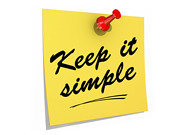 Over the years I’ve come to find the value of keeping things simple. In a way, the COVID-19 outbreak has forced us to keep things simple since we’re limited in what we can do, especially outside the house. Instead of running back and forth from place to place, we’re staying put, although we’re spending more time online.
Over the years I’ve come to find the value of keeping things simple. In a way, the COVID-19 outbreak has forced us to keep things simple since we’re limited in what we can do, especially outside the house. Instead of running back and forth from place to place, we’re staying put, although we’re spending more time online.
I realize the pandemic has also complicated our lives and brought with it a lot of stress and uncertainty. But during this time, we can find pleasure in simple things such as taking a walk, reading a novel, or baking bread (which is not keeping it simple for me since I don’t bake anything that involves yeast or rolling dough).
Keeping it simple doesn’t have to mean a bare-bones existence. There’s a Swedish term called lagom meaning everything in moderation or not too much, not too little. Right now, this can apply to how much we read about COVID-19 – enough to know what’s going on, but not too much so it’s overwhelming.
Keeping things simple is also important for your nonprofit organization. You’re going through a lot. You’ve had to make changes in the way you do your work. That may be providing limited contact or remote services or not be being open at all. Some of you may still be working from home, which can make your work more complicated.
You need to raise money and communicate with your donors fairly regularly, while not taking on too much. Donors are also going through a lot, but they want to help if they can and they want to hear from you. What they don’t want is a lot of complex content.
Here are a few ways to simplify your communication without making it too difficult for you.
Keep it simple by planning ahead
If communicating regularly with your donors sounds too overwhelming, plan ahead by using a communications calendar. You should be in touch every one to two weeks right now. Fill your calendar with different ways to do that. Think ask, thank, update/engage, repeat. And as I mention below, shorter communication is the way to go.
Keep it simple by sticking to one call to action
Your communication needs to be clear. Before you send an email message or letter, ask what is your intention? Is it to ask for a donation, say thank you, or send an update.
Stick to one call to action. If you pack too much information into your message, it’s likely your donors won’t respond to any of your requests.
In your fundraising appeals, don’t bury your ask. Make it relevant to the current situation. You can start with a story, followed by a clear, polite ask. Recognize your reader. Thank previous donors and invite potential donors to be a part of your family of donors.
Your thank you email or letter should thank the donor. Simple, right? Make them feel good about giving to your organization. Welcome new donors and welcome back returning donors. You don’t need a lot of wordy text explaining what your organization does.
Keep your messages simple, yet sincere, and include a clear call to action.
5 Nonprofit Email Call-to-Actions That Inspire Action
Keep it simple with shorter, easy to read messages
If your communication is too long, most people won’t read it. This is crucial now. People are getting so much information it’s hard to take it all in.
Limit print communication, such as newsletters and annual reports, to four pages or less. Your email messages should be just a few paragraphs. On the other hand, you don’t want to be terse or say too little.
Be sure your communication is easy to read and scan. Use short paragraphs, especially for electronic communication, and include lots of white space. Don’t clutter up the page.
Keep it simple by using conversational language
I find it annoying to read an appeal letter or newsletter article that sounds like a Ph.D. thesis. Write at a sixth to eighth-grade level. That’s what most major newspapers do. This is not dumbing down. You’re being smart by ensuring your donors will understand you.
Keep out the jargon and other confusing language. Instead of saying something like We’re helping underserved communities who are experiencing food insecurity, say – Thanks to donors like you, we can serve more families at the Eastside Community Food Bank.
We’re seeing real people being affected by real problems in real time. Don’t diminish this with jargon and other vague language.
Use the active voice and there’s no need to get fancy by using a lot of SAT vocabulary words. Again, you want your donors to understand you.
How Jargon Destroys Nonprofit Fundraising & Marketing
Make it easier for your nonprofit and your donors by keeping things simple.
Photo by One Way Stock
love this!! and of course your monthly donor blogs too!
LikeLiked by 1 person